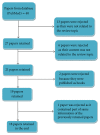Clinical Significance of Molecular Diagnostic Tools for Bacterial Bloodstream Infections: A Systematic Review
- PMID: 27974890
- PMCID: PMC5128711
- DOI: 10.1155/2016/6412085
Clinical Significance of Molecular Diagnostic Tools for Bacterial Bloodstream Infections: A Systematic Review
Abstract
Bacterial bloodstream infection (bBSI) represents any form of invasiveness of the blood circulatory system caused by bacteria and can lead to death among critically ill patients. Thus, there is a need for rapid and accurate diagnosis and treatment of patients with septicemia. So far, different molecular diagnostic tools have been developed. The majority of these tools focus on amplification based techniques such as polymerase chain reaction (PCR) which allows the detection of nucleic acids (both DNA and small RNAs) that are specific to bacterial species and sequencing or nucleic acid hybridization that allows the detection of bacteria in order to reduce delay of appropriate antibiotic therapy. However, there is still a need to improve sensitivity of most molecular techniques to enhance their accuracy and allow exact and on time antibiotic therapy treatment. In this regard, we conducted a systematic review of the existing studies conducted in molecular diagnosis of bBSIs, with the main aim of reporting on clinical significance and benefits of molecular diagnosis to patients. We searched both Google Scholar and PubMed. In total, eighteen reviewed papers indicate that shift from conventional diagnostic methods to molecular tools is needed and would lead to accurate diagnosis and treatment of bBSI.
Conflict of interest statement
The authors declare that there is no conflict of interests regarding the publication of this paper.
References
Publication types
LinkOut - more resources
Full Text Sources
Other Literature Sources


